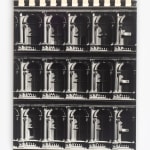Evelyn Hofer
Maquette for a Unique Calendar containing Hofer's Early Photographs, 1964
Photo album; Silver prints (44)
Overall 6 x 7 inches
Comb binding with calendar pages and a silkscreened cover.
Comb binding with calendar pages and a silkscreened cover.
Further images
-
(View a larger image of thumbnail 1
)

-
(View a larger image of thumbnail 2
)

-
(View a larger image of thumbnail 3
)

-
(View a larger image of thumbnail 4
)

-
(View a larger image of thumbnail 5
)

-
(View a larger image of thumbnail 6
)

-
(View a larger image of thumbnail 7
)

-
(View a larger image of thumbnail 8
)

-
(View a larger image of thumbnail 9
)

-
(View a larger image of thumbnail 10
)

-
(View a larger image of thumbnail 11
)

-
(View a larger image of thumbnail 12
)

-
(View a larger image of thumbnail 13
)

A unique calendar maquette comprising 44 stunning vintage prints, about half of which are from Hofer's seminal body of work, later published in 'New York Proclaimed' in 1965. The album...
A unique calendar maquette comprising 44 stunning vintage prints, about half of which are from Hofer's seminal body of work, later published in "New York Proclaimed" in 1965. The album is exceptionally tidy and each of the photographs is masterfully printed, displaying deep tonal ranges and sharp detail.
Hofer's prolific career spanned a half-century, and while her work was displayed in galleries and museums alike, she is perhaps best known due to her large output in book-format, making this piece a unique addition to her oeuvre of work. Throughout her career, she published numerous titles, calling attention to her strengths in building narratives and meaning through photographic sequencing.
Though not exactly a book, this maquette offers insight into Hofer's creative process in arranging and sequencing her photographs, particularly prompting the viewer to question their association with days, months, and the passage of time. Unlike many of her early publications, this maquette is not segregated by location. The selection of images includes various projects throughout Europe (London, Dublin, Spain, and Florence) with about half of the contents dedicated to Hofer's then-current work on New York City. This diverse collection showcases her ability to capture the essence of her subjects with precision and sensitivity, be these portraits, or compelling city views or landscapes.
Evelyn Hofer (1922-2009) was a German-born American photographer known for her exceptional skill in capturing portraits, cityscapes, and still-life images. She began her career in Switzerland before moving to New York City in the 1940s, where she began to gain recognition for her unique style and keen eye for detail. Despite her remarkable career, Hofer's work was relatively under appreciated during her lifetime. While the burgeoning style of street photography was dominated male photographers capturing spontaneous, loud images, Hofer preferred the careful precision of large-format cameras forcing a slowness between herself and the subjects. Her photographs, which include portraits, architectural and landscape views, are characterized by their subtlety and rigorous attention to detail. By working slowly and deliberately, Hofer aimed to capture the essence of her subjects and convey the distinct personality and character of the urban landscapes during a time of significant social, structural, and economic changes following World War II.
Hofer's prolific career spanned a half-century, and while her work was displayed in galleries and museums alike, she is perhaps best known due to her large output in book-format, making this piece a unique addition to her oeuvre of work. Throughout her career, she published numerous titles, calling attention to her strengths in building narratives and meaning through photographic sequencing.
Though not exactly a book, this maquette offers insight into Hofer's creative process in arranging and sequencing her photographs, particularly prompting the viewer to question their association with days, months, and the passage of time. Unlike many of her early publications, this maquette is not segregated by location. The selection of images includes various projects throughout Europe (London, Dublin, Spain, and Florence) with about half of the contents dedicated to Hofer's then-current work on New York City. This diverse collection showcases her ability to capture the essence of her subjects with precision and sensitivity, be these portraits, or compelling city views or landscapes.
Evelyn Hofer (1922-2009) was a German-born American photographer known for her exceptional skill in capturing portraits, cityscapes, and still-life images. She began her career in Switzerland before moving to New York City in the 1940s, where she began to gain recognition for her unique style and keen eye for detail. Despite her remarkable career, Hofer's work was relatively under appreciated during her lifetime. While the burgeoning style of street photography was dominated male photographers capturing spontaneous, loud images, Hofer preferred the careful precision of large-format cameras forcing a slowness between herself and the subjects. Her photographs, which include portraits, architectural and landscape views, are characterized by their subtlety and rigorous attention to detail. By working slowly and deliberately, Hofer aimed to capture the essence of her subjects and convey the distinct personality and character of the urban landscapes during a time of significant social, structural, and economic changes following World War II.












